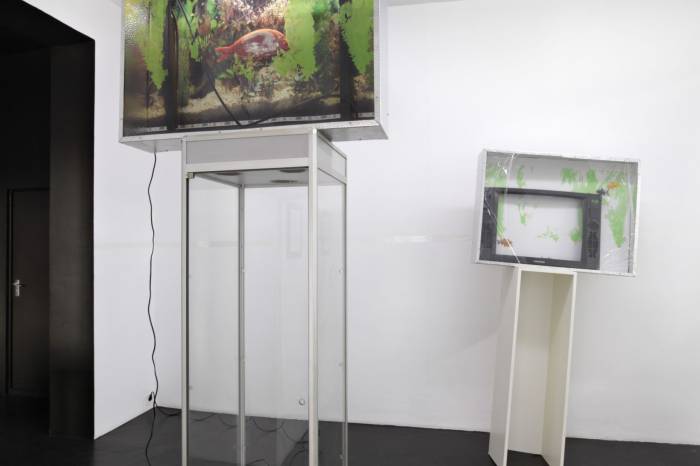Installation view Video Aquarium Sculptures; 2008.
Installation view Video Aquarium Sculptures; 2008.
Installation view Video Aquarium Sculptures; 2008.
“Television space is fishbowl space,” Vito Acconci declared in 1984, opening an essay on the relationship between television, furniture, and sculpture. Adopting this proposition, Video Aquarium Sculptures attempts to capture the story, history, and culture of television and laminate it onto the hardware that disseminated it – a way to reinvest the social and narrative layers into the television set as an object on the eve of its obsolescence.
The various works united under the mantle of this project track television hardware’s trajectory towards slenderness, from cathode ray tubes to the LED flatscreen monitors that constitute the contemporary state of the art. In parallel with the screen’s historical progress towards flatness, its ubiquity – and the volume of data that flows through screens everyday – has exploded, torrents of information channeled through the shallows of the internet. The project responds to this changing technological environment, tracing the shifts that occurred as peer-to-peer networks like the internet eclipsed the center-to-margins broadcast formats that preceded them.
Video Aquarium Sculptures challenges what it means to exhibit media art at this juncture, reflecting and confusing distinctions between materials – and thus the boundary between between “fine art” and “media art” as it has historically inhered. Sculpture, video, photography and painting are intermixed across these works to reflect media’s changing materiality at a historical point of inflection. Aquatic imagery – familiar from Nam Jun Paik’s TV sculptures and Acconci’s essay as much as from electronics shop retail displays – recurs across these explorations, the “fishbowl space” of the monitor restaged literally throughout three suites of format-defying sculptures.
A series of television monitors, growing slimmer as they get more contemporary, schematize the screen’s decreasing depth. The same trend is explored across sculptures that call themselves “videos”, comprised of canvases on stretcher bars printed with static images of aquariums depicted on screens of varying size and vintage. Alongside, a group of wall-mounted vitrines with plexiglass fronts hold the frames of destroyed TVs scavenged from the streets – the cast-off residue of a shift in household media consumption habits. Screen prints on the plexiglass fronts and wooden backs of the vitrines produce an animation effect as a viewer walks past – a kind of analogue video, gesturing towards early media art techniques. The resulting 4D media-archaeological deep-dive diagrams the evolution of hardware and art historical discourses alike, its deliberately convoluted claims suffused with a vaudeville, slapstick spirit.
-
Galerie Buchholz, Berlin/Cologne/New York
2009
Deep Sea Vaudeo
-
Lüttgenmeijer, Berlin, DE
2009
7 Drunken Videos
-
T293, Rome, IT
2009
Watching Videos Dry
-
Michael Lett, Auckland, NZ
2009
Starting from behind
-
Ursula Blickle Stiftung, Karlsruhe, DE
2008
Aquarium Videos
-
Center, Berlin, DE
2008
Simon Denny, Nick Austin: Aquarium Paintings
-
Brussels Biennial, Brussels, BE
2008
Brussels Biennial 2008
-
Sprengel Museum, Hannover, DE
2012
Made in Germany Zwei












